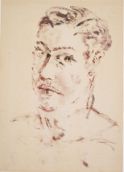"Alla dolce patria": il ritorno in Italia di Filippo de Pisis

The exhibition concentrates on the final phase of this Ferrarese artist’s paintings, the years between 1940 and 1953, which have never until now been the object of specific critical focus. The choice made by the curator includes 26 paintings and drawings from the Malabotta and Pianori donations and those belonging to the Gallerie di Arte Moderna e Contemporarea di Ferrara.
Following his return to Italy in 1939, Filippo de Pisis’ artistic production was deeply marked by growing anxiety and existential unease, revealed in a painting style at first over-elaborate in its expression and then increasingly stark. Bathed in somber tones and invaded by blinding whiteness, these paintings turn their back on the vibrant colours and pictorial glamour that had characterized much of de Pisis’ work in the 1930’s.
After 1939 de Pisis continued painting for little more than a decade, during which time he inaugurated a new phase, marked by terser and more concise forms. With the decline in his health, this change in direction became increasingly evident. Ritratto di Allegro - Portrait of a Cheerful Man (1940), on display here, for the first time clearly shows this change. The painting, reduced to the bare essentials, leaves large parts of the canvas free (as will happen repeatedly in the future), the structures are leaner, the face is defined by a few summary features, and in the background we find the device of the painting within the painting, recurrent in many of de Pisis’ works.
It is in this last phase of de Pisis’ career that the artist produced his most cohesive and consistent group of drawings. Many of these remarkable works are housed in the rooms of this museum. In these drawings what is detracted from the form can be found in the material - red chalk, pastel or oil, which clash with the sureness and neatness of the line, as we can admire in the numerous nudes that represent the artist’s favourite subject-matter in this series.






